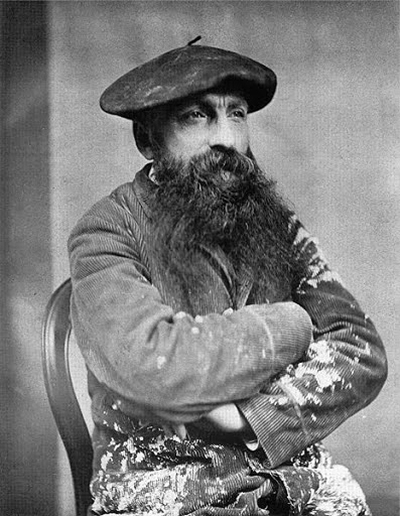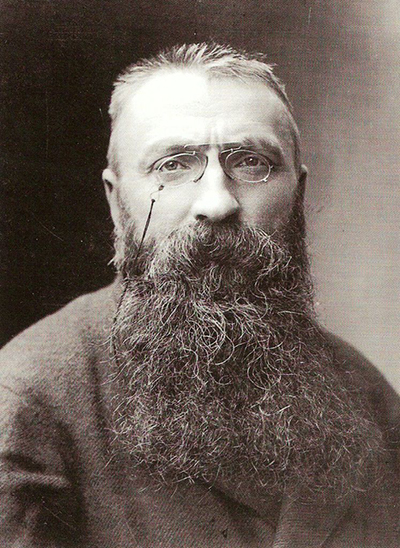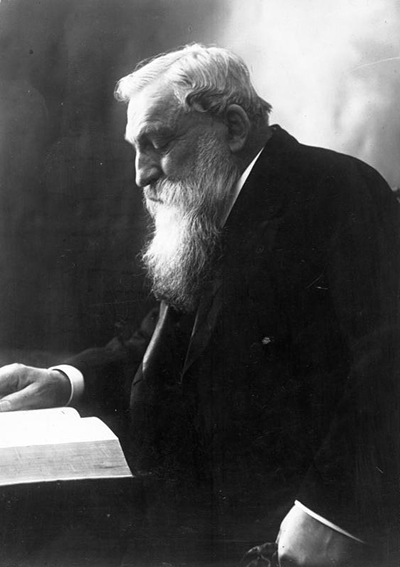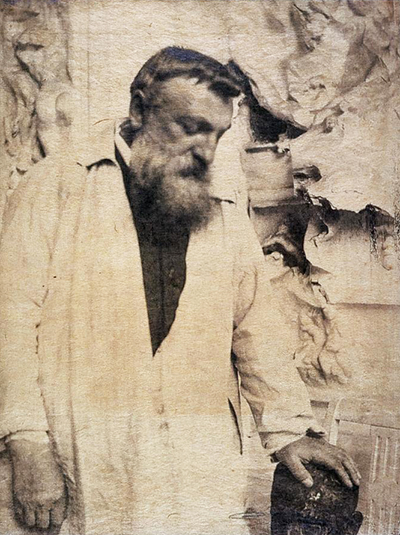Photography would become an important means by which we can document the life and career of Auguste Rodin. Helpfully he would would hire some of the most respected photographers in France to capture him at work, as well as recording some of his sculptures in different states of completion.
Ever since the early days of photography, there seemed a strong bond between it as a discipline and that of sculpture. Many of the prominent early photographers would use plaster and marble statues as subjects for their work, long before it was widely accepted as a genuine art form in it's own right. The early uses by Rodin of photography was for the purposes of providing evidence as to the methods with which he produced certain sculptures. His level of accuracy was considered so revolutionary that some raised questions about his work. By providing photographs of his models as well as the completed artwork in its earlier phases of development, he could finally quieten these voices. Rodin would have felt it a shame to have to go to these lengths in order to be judged fairly, but he would not allow something that he had worked tirelessly to achieve have its reputation damaged by a selection of narrow minded, negative academics. The Age of Bronze is one example of how he convinced the Paris Salon of its honest production techniques and soon after this he would start to receive less push back on future projects.
Whilst appreciating the benefits that photography could bring to his career, Rodin did not see it as a genuine art form. It was a reproduction facility that had all manner of uses, but art should not be one of them. He always loved the third dimension provided by sculpture, and felt that photography was merely a two dimensional rendering of a moment in time. This was was entirely typical of the time and it would not really be until around the 1950s that the academic world would collectively begin to treat it with anything like the same level of respect that had been afforded the great painters and sculptors of the time. That said, Rodin did see its potential as a tool to aid his own work, and would have regular photographs taken in order to record and appraise his sculptures during their development. He would also use photographs of completed sculptures to spread his reputation further across Europe without having to leave the comfort of his studio.
"...If, in fact, in instantaneous photographs, the figures, though taken while moving, seem suddenly fixed in mid-air, it is because, all parts of the body being reproduced exactly at the same twentieth or fortieth of a second, there is no progressive development of movement as there is in art. […] it is the artist who is truthful and it is photography which lies, for in reality time does not stop, and if the artist succeeds in producing the impression of a movement which takes several moments for accomplishment, his work is certainly much less conventional than the scientific image, where time is abruptly suspended..."
By the end of his career, Rodin had collated around 7,000 photographic prints which served a variety of purposes. In some cases he would actually have photos made of his sculptures before then sketching over the top as he considered different ways to develop them. He would use pen, pencil or brush to come up with all manner of effects and in this case he clearly regarded these photos are dispensible, as part of his sculptural process. He might also amend these photos by hand in order to lead the photographer in making new versions, perhaps to just accentuate part of a sculpture. In other cases he would refer to these adapted prints when painting, drawing or sculpting himself. There would become a fairly fluid relationship between all of these mediums and as his career developed he would start to understand how to better use them together. The biggest aid to those documenting his life and career have been the pictures taken of his various completed sculptures, often just before they are exhibited for the first time. This provides us the freshest view of each piece. Rodin called on the services of the likes of Gaudanzio Marconi, Karl Bodmer, Victor Pannelier and E. Freuler in order to get the finest depictions of his work possible, which seems entirely reasonable considering the amount of time and energy that he spent on each one in the first place.
It was only in recent decades that the importance of his collection of photographic prints has received greater focus. For many years after his death it was entirely ignored, even after the formation of a museum dedicated to his life. Efforts have since been made to preserve and document the many items, as well as collating photographs of the artist from other sources. The Musée Rodin has played the biggest role in this, and this venue continues to be the biggest draw for the sculptor's many supporters. Les photographes de Rodin was an important publication in 1986 which continued the process of drawing these items together in a more organised and comprehensive fashion. They then released Rodin et la photographie in 2007, in collaboration with Hélène Pinet. As the significance of the art form continues to rise, it is likely that such a focus on the impact of photography within the career of Rodin will also continue to grow in momentum. Additionally, a Rodin retrospective in Washington, 1981, showed the potential of including these photos alongside his drawings, paintings and sculptures as a means to widening the scope and interest of the exhibition.
The Musée Rodin how holds around 25,000 photographic items from his career in total, including the 7,000 that the artist collected him, as mentioned earlier. It provides a rich resource of visual information, covering his life from 1877 to 1917, with the vast majority coming from his life in and around his studio in Paris. To even start to collate and document this many items with a huge undertaking and perhaps explains why it has taken until just the last few decades that we are now able to understand it much better. The newspaper cuttings help us to track the popularity of the artist across his career, whilst the photographs that he commissioned himself offer us invaluable insights into his progression as an artist. A number of pictures that made their way out of his possession have come up for sale in recent years, with several commanding valuations in the thousands of pounds or euros. There does seem an acceptance now of the huge significance of this art form within his career, in many different ways.
Some of the photographers used most commonly by Rodin were Pierre Choumoff, Albert Rudomine, Jacques-Ernest Bulloz and Alphonse Eugène Druet. They recently appeared within a London exhibition which attempted to explain how Rodin would serve as art director, leading them in how he wanted his prized sculptured to appear. Whilst he thoroughly respected their own abilities, he was hiring them for his own needs and so wanted to ensure that these requirements were met. He didn't believe anyone could understand himself or his work without a clear explanation and was particularly fussy with regards how his sculptures were perceived. He became sensitive to criticism and therefore wanted to go the extra mile in every aspect of how his creations were produced and displayed. This extreme level of control is not unusual within the careers of the greatest artists in European history, and can be seen as much as a postive strength as a negative. He would suggest ideas around lighting and angles to them, and to be fair, no-one could ever understand his statues as well as him.
One interesting development within Rodin's career would be the point at which he would start to exhibit different mediums together. Whilst known only as a sculptor by most, towards the end of the 19th century he began to place drawings and sculptures together, and soon he would be including photographs too as a means to showing the viewer his creative methods. Whilst he had originally commissioned these photographs as a way of providing supporting evidence to his own honesty, he later saw how they could add extra interest to his exhbitions. Those more unfamiliar with the art world could understand the artist much better by peering directly into his studio in this way. It could potentially also attract younger students into entering the world of sculpture at a time when they were being introduced to so many different ideas and techniques. He was truly passionate about this medium, and saw other disciplines as a means to supporting his main focus.
Over time, Rodin would look beyond France to welcome photographers from abroad. He wanted only the best that he could find, and so felt it worthwhile to try out others from abroad. We have found examples of where he has been so delighted with specific photographs that he would offer one of his own sculptures as payment, and this type of deal was normally snapped up. One example would be Gertrude Käsebier who came over from the US in order to complete a variety of projects within Europe. Whilst Rodin's sculptures were extraordinary, the artist himself also held a charismatic character which could also be used effectively by the finest photographers. With Rodin's base being in central Paris, anyone travelling from the States would surely have spent considerable time in Paris in any case, making a trip to his mansion an obvious decision. As mentioned previously, as well respected as French painters were at this point, their medium was not as suitable to photography as the three dimensional sculptures from the likes of Rodin. They were offered many creative opportunities, such as close ups of the contours of each piece, or to step back and capture whole rooms within his impressive studio.
Rodin was entirely open-minded when it came to selecting models for his work. We do, however, find a clear trend with the lucky few who were able to pose for him. He did not care whether the models were professionals or not, and would often pull in figures that he met in his daily life, if he spotted particular characteristics. One example would be Auguste Neyt, a telegraphist, who attracted the sculptor with his muscular, toned physique. They would become friends for life after he posed several times and several photographs remain from this time. As a sort of art director, Rodin would be very involved in the model's work whether they were professional or not, and so he did not need any prior experience for this task. At other times he would have several options pose together before making a choice there and then within his studio. The physique of the Auguste Neyt might remind some of the world's most famous sculpture of all, David by Michelangelo. There is barely an ounce of fat upon this impressive body, giving the sort of look that most of us would aspire to all these years later.
Les Bourgeois de Calais (The Burghers of Calais) and The Thinker would perhaps be the two sculptures from Rodin's career that would be the most photographed of all. There are endless pictures of them in all manner of different guises, both indoors and outdoors and from a wide variety of photographers. The two are now regarded as being amongst the most famous sculptures in history and to find all this extra visual documentation around them is a huge boon for academics looking to understand as much as possible about their creation and early life with the artist's studio. Rodin himself saw his best work as living organisms and this might explain how he could justify spending quite so much time in the early stages of development on some of his major projects. It was almost as if he was bringing something to life, as if planning the birth of his own child or lover, and this romantic and emotional nature was the absolute key to this sculptor's considerable success. Whilst not being valued as much during his own lifetime, at least not by academics, the photographs of his life and career have provided whole new strands of interest and potential investigation for followers of his today. Modern exhibitions are finally starting to recognise this and so a collated documentation of at least some of his photographs in a form similar to a catalogue raisonne may not be too far off.




 1898.jpg)
 taken by Pierre Choumoff.jpg)
 taken by Alphonse Eugene Druet.jpg)



